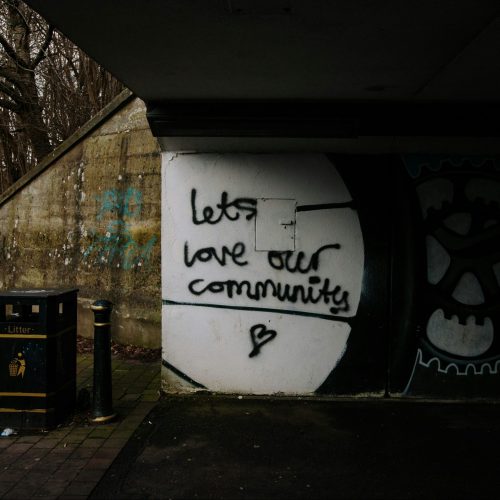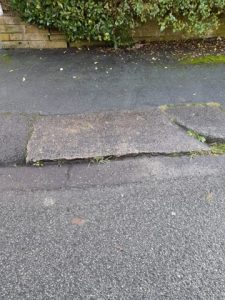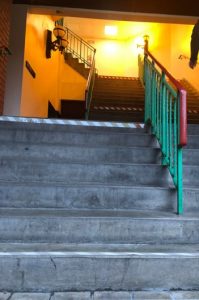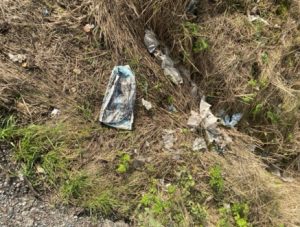Article: Picturing Community Wealth: A photovoice project with young people in Wigan

Following a brief overview of Community Wealth Building, this article outlines the photovoice process with young people, which revealed barriers to employment and young people’s everyday interactions with the world.
Community wealth building is an ethical approach to economics that draws on the existing strengths of local communities to harness wealth (Dennis and Stanley, 2023). To date, there has been little involvement of young people in developing community wealth building strategy although a key aim of this approach is to provide aspiration and local opportunities for young people. Recognising the need for co-production, Wigan Council, in North West England, wanted to hear from marginalised young people to feed their views and experiences into their community wealth building agenda. To this end, the Council collaborated with the University and several local social enterprises on a research and knowledge exchange project. This provided education in some of the main principles of community wealth building, including social enterprise, volunteering and sustainability.
This article discusses one aspect of the project, photovoice research with young people not in education or employment (NEET)¹ who lived in Wigan. This involved the participants, aged 17-23, taking photographs that represented their thoughts and everyday experiences of their local community, environment, work and hopes for the future, and discussing them in a group setting. The article begins with a brief overview of community wealth building then outlines the photovoice process which revealed barriers to employment and young people’s everyday interactions with the world. It concludes by considering the implications for community wealth building.
Community Wealth Building
Community wealth building is a bottom-up approach to community economic development, which might be understood as a kind of ‘de-globalisation of capital’ (Dennis and Stanley, 2023). It began in the US and has recently gained considerable traction across the UK where the Preston model is the best-known example. Community wealth building draws on the strengths that already exist in a place and seeks greater democratic ownership, participation, and control of local economies (Hanna and Kelly, 2021). It does so through a range of policies and activities such as the procurement strategies of anchor institutions (eg universities, large businesses, NHS trusts); the development of the social enterprise sector including community businesses; and emphasis on public ownership and community land trusts.
There is no ‘model’ of community wealth building that can be lifted and applied to other localities. It is a collaborative, relational venture which enables partners to work in the most appropriate ways for the local area. Preston, another North West town, has been at the vanguard of community wealth building in the UK and has seen it lead to skill development and job creation for young people through the policies and activities outlined above. This meant ‘starting from an assessment of local need to identify the unique circumstances of Preston’s economy and how community wealth building might be moulded to meet these strategic challenges’ (CLES and Preston City Council 2019, p.23). In Wigan, there is a desire to raise aspirations for young people and a need to provide opportunities locally. In recent years there has been a significant increase in the number of young people in Wigan who are out of work, education or employment, and who have physical and mental health challenges (Nandy, 2024). Hanna and Kelly (2021, p.5) understand the need for state involvement in such issues but suggest that there is potential for community wealth building to ‘tip the balance of power between community economies and the corporatist state as it increases individual and collective voice, agency, and empowerment.’ It is important that young people’s voices are included given the turbulent world they are inheriting.
It is useful to understand the ‘community’ aspect of community wealth building in terms of social relationships. It is a condition of being rather than something that can be ‘lost’ or ‘saved’ and might thus be thought of a ‘communal beingness’ (Studdert and Walkerdine, 2016). This means that more sensitive, relationally oriented approaches – such as co-production of knowledge – become necessary if we are to succeed in more positive outcomes both on the ground and in achieving policy goals (Wills, 2016, p.640). From this stance, politics might be about acknowledging existing relationships, ‘exploring what the people are already doing and the obstacles that get in the way’ (Wills, 2016, p.647).
Photovoice
Photovoice is committed to social transformation and encourages members of marginalised groups to work together to ‘identify, represent and enhance their community through a specific photographic technique’ (Wang and Burris, 1997). Participants are invited to take photographs in their everyday lives to respond to the theme or themes of the research in a way that is ‘grounded in the practices and culture of the informants’ (Green and Kloos, 2009, p.461) and thus enables them to guide the agenda. They bring the resultant images to the photovoice sessions where they are discussed in the group, enabling ‘critical dialogue’. Encouraging and facilitating this dialogue might be understood as a means of giving voice to those who are typically unheard (Walton et al, 2012).
On a more practical level, photovoice does not privilege the written word and can be a useful method of working with young people who tend to be well practised in taking photographs on their phones. The process involves multiple roles for photovoice participants – not only are they research participants, but also photographers and co-researchers who have responsibility over data collection, analysis and dissemination (see Palibroda et al, 2009). In our project some of the young people took on roles of artists and designers too as we developed and published a photostory in the form of a pamphlet. They launched this at an event which included an audience of academics and members of the council.
In collaboration with one of the social enterprises, we recruited several participants, ranging in age from 17 to 23. Some of them knew each other because they volunteered for a social enterprise that delivered disability education; others were new to the group. We met weekly for two hours over seven weeks, and sessions included an hour of education and an hour of photovoice. Young people were provided with four key themes to respond to through photographs: work, community, environment, and hopes and dreams for the future. They were discouraged from taking recognisable photographs of other people, and we considered the notion of ‘metaphorical’ photographs that represented an idea rather than (or as well as) a literal depiction.
Participants’ photographs always provoked much discussion which was recorded by note taking. Young people were encouraged to talk freely and to prioritise whichever issues they wanted to. They generally stuck to the themes of the research (with occasional snaps of participants’ dogs diverting us from time to time; a love of dogs united the group) but there was much more emphasis on physical surroundings and barriers than expected, as discussed below.
Photovoice themes: Struggle, Environment and Respect
One young woman (who was physically disabled) had taken several photographs of a street close to her home which depicted cars parked on the sides of the road and the uneven pavement, its paving stones sticking up at hazardous angles [Fig 1]. She told us that this meant it was difficult for her to get out. Her mother had once fallen and broken her elbow here and was worried about her daughter meeting a similar fate. She would insist on accompanying her and holding onto her backpack to keep her steady. If the street was cared for and repaired, it would give her independence, the participant said. A wheelchair user in the group was prompted to talk about the streets near her home where cars parked on the pavement; this meant she could not get through in her wheelchair. The young people agreed there is too much traffic on the streets, and another young woman spoke of how she had to keep the curtains in her bedroom closed all day so that people on the passing buses could not see in. She spent much of her time in this room.
 Figure 1: Pavement
Figure 1: Pavement
As we sorted the photographs into themes, images of grey pavements began to stack up. Stairs also featured heavily: harsh concrete flights as well as more domestic ones. One participant, a young man, explained what the stairs in his photograph represented: ‘In life you don’t get a lift to the top. You have to take the stairs and deal with situations as they arise. There are barriers but we accept the challenge.’ [Fig 2] A young woman (who had spent time in care) described hers: ‘This picture represents how sometimes our homes don’t feel safe. They give us an unsteady feeling, fighting to keep ourselves upright.’
 Figure 2: Stairs
Figure 2: Stairs
Although there was much discussion of physical environment, there was a lack of engagement in discussion of the natural environment and climate change. Acknowledging this crisis requires capacity to imagine future worlds (Solnit, 2014) which is perhaps difficult when so much energy is being used to ‘stay upright’ in the present. It was photographs of litter that exemplified most of the young people’s responses to the theme of the environment [Fig 3]. They were upset by litter; there were not enough bins in the area, they pointed out, and they had even known bins to be stolen. One of the dog-lovers was ‘terrified’ her puppy would cut its paws on the broken glass strewn across the streets near where she lived. It was the physically disabled young people who were most notably affected by litter on the ground because, like uneven paving stones, it presented a hazard: ‘If it’s slippery or muddy, I can’t walk. I’ve got no independence …. Litter adds to the slippiness. I can’t walk at all’.
 Figure 3: Litter
Figure 3: Litter
The disabling impact of litter was of interest to the able-bodied members of the group who were able to empathise. One commented that ‘people don’t think about what’s difficult to other people’. One young person talked about how the litter revealed a lack of respect people have for themselves and the area: ‘It’s like going to a job interview in scruffy clothes –you’re less likely to be respected’. It was also observed that most of the litter on the ground was from unhealthy food and drink: ‘People are not bothered about themselves so why would they be bothered about anyone else?’ Another participant agreed that litter ‘brings the place down’. He told the group, ‘I buzz off seeing people litter picking’ but admitted that he wouldn’t do it himself in case someone thought he was doing community service.
One of the young people had taken a carefully arranged photograph of her sweatshirt emblazoned with the logo of the organisation she volunteers for, her wallet placed on top. Explaining the image, she initially spoke of the pride she feels being a volunteer for the organisation, but then disclosed her shame that she did not ‘earn a living’ and was reliant on benefits: ‘the system’s not designed to get [disabled] people into work. You can get more money from benefits than from working…. Sometimes I don’t feel comfortable with people paying for my lifestyle but at least I’m doing something to contribute to society.’ She then brought up an incident that had happened in our lunchbreak when she had struggled to manoeuvre her wheelchair around a local shop, dropping her shopping basket in the process. She had needed help which, although it was forthcoming, she was upset about. She wanted to be able to pay her own way and not be reliant on the kindness of others.
Discussion
These conversations chimed with Elliott et al’s (2020) findings from creative research with young people living on an estate in a post-industrial town in South Wales. Their participants also photographed litter and spoke about a lack of respect for their town by some community members, as well as a stigmatising narrative that existed of the place. Elliott et al point out that their participants could be seen to challenge the dominant narrative that young people ‘are the source of disorder and disrespect in the community’ given that those taking part in their projects were concerned with ‘what they felt was the desecration of place’ (2020, p.169). However, Elliott et al also found that whilst the young people in their research acknowledged ‘the social and environmental scars of poverty’, their everyday experiences were not articulated ‘in relation to the unjust structures that reproduce inequality’ (2020, p.169).
So many of the images produced during our project were colourless and ordinary. Yet they revealed some of the ways that physical surroundings – so familiar that they tend to go unremarked – intensified the social disadvantages participants faced. The young people encountered barriers, physical and psychological, to participating in society. The example our participant gave of being helped with her shopping is an instance of a mundane, micro-social interaction necessary for communal being-ness (Studdert and Walkerdine, 2016). Her ambivalent reaction to this was perhaps not surprising given her feelings of being a burden to society despite the valuable contribution made through her volunteering. Yet it is these inter-relations with other people, as well as with buildings and materiality more widely, that form communal life. Approaching these everyday environmental issues through the lens of community wealth building emphasises young people’s needs.
The research process of photovoice enabled the development of important relationships with young people. One young man would come to the sessions early and show me reams of photos on his phone of his family, friends and animals before we got started. These images were not used as data, but the micro-interactions worked as a way of us getting to know each another and establishing a sense of trust. A young woman grew remarkably in confidence through the process. When we first met, she was quiet and withdrawn, her long hair obscuring her face. She had had a troubled past, leaving school very early, and spending some time in care. She had never worked. She led the presentation given at university to the Councillors and Academics, and she also volunteered to co-present at an academic conference three months after the end of the project. When I met her to plan our conference presentation, she told me that she had got a full time, well-paid permanent job and had taken a day of her annual leave to meet me.
Conclusion
Previous research on community wealth building has highlighted important mechanisms of collaboration between stakeholders as an ‘“embroidery” of linking people, activities and processes within and across institutions’ which ‘requires a relentless focus on everyday practice’ (CLES and Preston City Council, 2019, p.25). Within our project, these stakeholders also included young people, who potentially have the most to gain from the transfer of wealth and power back to local communities. The young people in our project had a great deal to offer, turning up on time each week, participating enthusiastically and making smart and spirited contributions which illustrated their desire for respect and for a better, cleaner environment. The photovoice process encouraged sharing and deep listening and proved a way of engendering the communal being-ness which was so needed. Creating such relationally oriented opportunities is necessary for developing community wealth building if it is to make a real difference to young people’s lives.
Youth & Policy is run voluntarily on a non-profit basis. If you would like to support our work, you can donate any amount using the button below.
Last Updated: 12 February 2025
Footnotes:
¹NEET is a problematic term and it was not one we used in the project. It defines young people ‘by what they are not, rather than who they are’ and gives the same label to ‘a diverse range of individuals with very different circumstances and prospects’ (Simmons et al, 2014: 578).
References:
CLES and Preston City Council (2019) How we built community wealth in Preston: Achievements and lessons. Available at https://www.preston.gov.uk/media/1792/How-we-built-community-wealth-in-Preston/pdf/CLES_Preston_Docu
Dennis, J. & Stanley, L. (2023) The de-globalisation of capital? The political economy of community wealth building. New Political Economy, 28 (5): 677-692
Elliott, E., Thomas, G.M. & Byrne, E. (2020) Stigma, class, and ‘respect’: Young people’s articulation and management of place in a post-industrial estate in South Wales People, Place and Policy 14(2): 157-172.
Green, E. & Kloos, B. (2009). Facilitating youth participation in a context of forced migration: A photovoice project in Northern Uganda. Journal of Refugee Studies, 22: 460–482
Hanna, T.M. & Kelly, M. (2021) Community Wealth Building: The Path towards a Democratic and Reparative Political Economic System. Democracy Collaborative, January 2021. Accessible at: https://www.democracycollaborative.org/whatwethink/community-wealth-building-the-path-towards-a-democratic-and-reparative-political-economic-system
Nandy, L. (2024) Lisa Nandy MP: It is vital to get our young people working or learning. Wigan Today, 16th March. Accessible at: https://www.wigantoday.net/news/politics/lisa-nandy-mp-it-is-vital-to-get-our-young-people-working-or-learning-4552677
Palibroda, B. with Krieg, B., Murdock, L. and Havelock, J. (2009) A Practical Guide to Photovoice: Sharing Pictures, Telling Stories and Changing Communities. Winnipeg: The Prairie Women’s Health Centre of Excellence.
Power, N. G., Norman, M.E. & Dupré, K. (2014) Rural youth and emotional geographies: how photovoice and words-alone methods tell different stories of place, Journal of Youth Studies, 17:8, 1114-1129
Solnit, R. (2006) Lost. Edinburgh: Cannongate.
Studdert, D. and Walkerdine, V. (2016) Being in community: re-visioning Sociology: Editorial introduction The Sociological Review, Vol. 64, 613–621.
Walton, G., Schleien, S.J., Brake, L.R., Trovato, C. and Oakes, T. (2012) Photovoice: A collaborative methodology giving voice to undeserved populations seeking community inclusion. Therapeutic Recreation Journal 46 (3): 168–178.
Wang, C. and M. A. Burris (1997) Photovoice: Concept, methodology, and use for participatory needs assessment. Health Education and Behaviour, 24(3): 369-387.
Wills, Jane (2016) (Re)Locating community in relationships: Questions for public policy The Sociological Review, Vol. 64, 639–656.
Biography:
Victoria is Director of the Centre for Social Responsibility and Associate Head of History, Geography and Social Sciences at Edge Hill University in Lancashire, UK. She is also Visiting Professor of Community-Engaged Scholarship at the University of Central Florida Downtown. She is committed to civic engagement and works collaboratively on research and knowledge exchange projects with local government, organisations and marginalised communities.